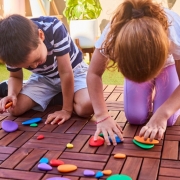Supporting creativity and imagination in the early years
Unleashing limitless potential through creativity and imagination in early childhood
When children are imaginative and creative, they develop their problem-solving and critical thinking skills, which are necessary for navigating different situations and making informed decisions throughout their lives.
We know that supporting creativity and imagination in the early years can take on many forms, in many different environments. In this blog, we will explore how Edx Education, with years of experience, supports creativity and imagination in young children.
Supporting at home
Settings, including home, play a significant role in supporting creativity and imagination in young children. Parents and caregivers should provide opportunities for children to engage in imaginative play, which involves pretending and make-believe.
Explore surroundings both inside and outside, and encourage children to make their own decisions, to promote critical thinking and problem-solving skills. Note that it is important for children to take (safe) risks and make mistakes, which encourages their curiosity and resilience.
Parents and caregivers should also encourage children to ask questions, and then ask questions in return, which stimulates a child’s curiosity. The use of open-ended toys enables children to use their imagination and creativity to create their own play scenarios.
Creativity and imagination are essential skills that should be nurtured in young children as they play a crucial role in their holistic development.
Supporting in external settings
In addition to home-based settings, attending a variety of settings can support creativity and imagination in young children. For instance, childcare centres, nurseries and preschools will provide a safe and stimulating environment that promotes imaginative play.
Supporting creativity and imagination in the early years is especially important in settings where children spend most of their day. The areas of learning in the foundation stage of the curriculum provide a framework for supporting children’s development, including their creativity and imagination.
The areas of learning include communication and language, physical development, personal, social, and emotional development, literacy, mathematics, understanding the world, and expressive arts and design. Each area of learning plays a significant role in supporting children’s creativity and imagination.
Through imaginative play, children can express their thoughts and emotions, which enhances their communication skills. The use of different media such as paint, clay, and fabrics enables children to explore their creative potential. Also, by creating art, children develop their fine motor skills, which are essential for their physical development.
Children should have access to a variety of toys that stimulate their imagination, such as dress-up costumes, puppets, and building blocks.
Our top 10 creative activities to aid imagination
Edx Education has been providing high-quality educational resources and toys for children for many years. We have a range of toys that have been designed to promote creativity and imagination children in the early years. With our approach being child-centred, we make sure that every child’s unique needs are met. With this approach, children have the opportunity to develop at their own pace, and their creativity and imagination are allowed to flourish.
- Drawing and colouring: Drawing and colouring allows children to express themselves through art and use their imaginations to create new and unique designs.
- Building with blocks or construction sets: Building with blocks or Legos requires children to use their imagination to construct new designs and structures.
- Playing dress-up: Playing dress-up enables children to imagine themselves in different roles and scenarios, which promotes their creativity and imagination.
- Board games: Playing board games requires children to use their critical thinking and problem-solving skills, which in turn promotes patience, creativity and imagination.
- Making crafts: Making crafts, such as junk modelling or papier mâché, encourages children to use their imagination to create new and unique designs.
- Music and dancing: Playing with musical instruments, such as a xylophone or drum set, and dancing along to different beats, encourages children to use their imaginations to create new and unique moves and melodies.
- Playing with puppets: Playing with puppets provides an opportunity for children to express themselves creatively and use their imaginations to create stories and scenarios.
- Engaging in pretend play: Pretend play allows children to imagine themselves in different roles and situations, which promotes their creativity and imagination.
- Storytelling: Storytelling enables children to create their own narratives and use their imaginations to develop new characters and settings.
- Outdoor exploration: Exploring nature and the outdoors provides children with an opportunity to use their imaginations and explore new environments.
Supporting creativity and imagination by learning through play in the early years is crucial for young children’s development. By providing children with opportunities to engage in imaginative play, explore their surroundings, and make their own decisions, they can develop their critical thinking, problem-solving, and communication skills, which are essential skills for life.
Shop our full range of educational products for children of all age groups, abilities and developmental stages here:
USA www.amazon.com/edxeducation
Edx Education – Heather Welch
To find your local Edx Education retailer head over to Where to buy – Edx Education.



 Edx Education
Edx Education